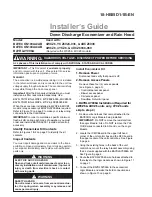
31
English
INFORMATION
The refrigerant charge operation will automatically stop within 30
minutes. If charging is not completed after 30 minutes, perform the
additional refrigerant charging operation again.
Perform the test procedure as described in 15.4.2. Test operation on
page 41.
INFORMATION
• When a malfunction is detected during the procedure (e.g., in case
of closed stop valve), a malfunction code will be displayed. In that
case, refer to 15.5. Malfunction code list on page 41 and solve the
malfunction accordingly. Resetting the malfunction can be done by
pushing BS3. The procedure can be restarted from 6).
• Aborting the refrigerant charge is possible by pushing BS3. The unit
will stop and return to idle condition.
If any malfunction code is displayed, close valve A immediately.
Confirm the malfunction code and take corresponding action, 15.5.
Malfunction code list on page 41.
14.3.3. Final charge adjustment
It is not necessary to do this final adjustment normally, but perform the
following operation only when if the most adequate refrigerant for the
best performance is required.
The outdoor temperature must be between 60°F (16°C) and 97°F
(36 °C).
Purge gauge lines. Connect service gauge manifold to the service
port between the compressor and the reversing valve in each outdoor
unit. Run the system for 30 minutes in cooling by the forced operation
using the field setting mode [2-6] (value 0: OFF, 1:ON) (Refer to 15.2.
Monitoring function and field settings.) to allow pressures to stabilize,
then check subcooling as detailed in the following sections.
Subcooling = Sat. Liquid Temp. – Liquid Line Temp.
1
Temporarily install a thermometer on the liquid line between the
coil and the EV in each outdoor unit. Ensure the thermometer
makes adequate contact and is insulated for best possible read-
ings. Use liquid line temperature to determine sub cooling.
2
Check subcooling for each outdoor unit and calculate the average
subcooling of the outdoor unit. Systems should have a subcooling
of 11±3°F (6±2°C).
a. If average subcooling is low, add charge to raise subcooling to
11±3°F (6±2°C) (The maximum additional charge is 4.4 lbs.
(2kg))
b. If average subcooling is high, remove charge to lower the sub
-
cooling to 11±3°F (6±2°C)
14.3.4. Checks after adding refrigerant
• Are all stop valves open?
• Is the amount of refrigerant, that has been added, recorded on the
refrigerant charge label?
NOTE
Make sure to open all stop valves after (pre-) charging the refrigerant.
Operating with the stop valves closed will damage the compressor.
15.
Start-up and configuration
INFORMATION
It is important that all information in this chapter is read sequentially by
the installer and that the system is configured as applicable.
DANGER: ELECTRICAL SHOCK
See Safety considerations on page i.
15.1. Checks before initial start up
After the installation of the unit, first check the following items. Once all
below checks are fulfilled, the unit must be closed, only then can the
unit be powered up.
1
Installation
Check that the unit is properly installed, to avoid abnormal noises
and vibrations when starting up the unit.
2
Field wiring
Be sure that the field wiring has been carried out according to the
instructions described in 9. Field wiring on page 19, according to
the wiring diagrams and according to the applicable legislation.
3
Power supply voltage
Check the power supply voltage on the local supply panel. The
voltage must correspond to the voltage on the identification label
of the unit.
4
Ground wiring
Be sure that the ground wires have been connected properly and
that the ground terminals are tightened.
5
Insulation test of the main power circuit
Using a megatester for 500 V, check that the insulation resistance
of 1 MΩ or more is attained by applying a voltage of 500 V DC
between power terminals and ground. Never use the megatester
for the transmission wiring.
6
Fuses, circuit breakers, or protection devices
Check that the fuses, circuit breakers, or the locally installed pro-
tection devices are of the size and type specified in 9. Field wiring
on page 19. Be sure that neither a fuse nor a protection device has
been bypassed.
7
Internal wiring
Visually check the control box and the inside of the unit on loose
connections or damaged electrical components.
8
Pipe size and pipe insulation
Be sure that correct pipe sizes are installed and that the insulation
work is properly executed.
9
Stop valves
Be sure that all stop valves are open.
10
Damaged equipment
Check inside of the unit on damaged components or squeezed pipes.
11
Refrigerant leak
Check inside of the unit on refrigerant leakage. If there is a refriger-
ant leak, try to repair the leak. If the repair is unsuccessful, call your
local dealer. Do not touch any refrigerant which has leaked out
from refrigerant piping connections. This may result in frostbite.
12
Oil leak
Check the compressor for oil leakage. If there is an oil leak, try
to repair the leak. If the repairing is unsuccessful, call your local
dealer.
01_EN_03_3P734038-2.indd 30
01_EN_03_3P734038-2.indd 30
2023/05/29 11:59:58
2023/05/29 11:59:58
















































